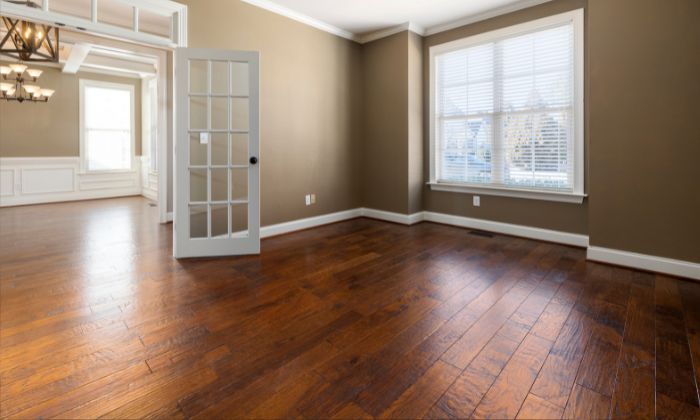 30 seconds summary
30 seconds summary
- For high-traffic residential and commercial spaces, durable flooring options like porcelain tile, luxury vinyl, engineered wood, and concrete offer long-lasting performance, easy maintenance, and aesthetic versatility.
- Choosing the right material ensures resistance to wear, moisture, and heavy use.
- Using an online tile store can simplify the selection process with a wide range of affordable, stylish options.
When it comes to choosing flooring for spaces that endure heavy foot traffic, durability is key. Both residential and commercial areas—be it bustling kitchens, busy hallways, or crowded office lobbies—require flooring that can withstand constant use without showing signs of wear. Fortunately, today’s flooring market offers a wide range of tough, aesthetically pleasing, and low-maintenance options. In this comprehensive guide, we’ll explore the most durable flooring choices, highlight their advantages, and provide practical tips for choosing the right material for your specific needs.
The Importance of Durable Flooring
High-traffic spaces are subject to more than just foot traffic. They face challenges such as moisture, spills, dirt, abrasions, and furniture movement. Poor-quality or inappropriate flooring can quickly deteriorate, leading to safety issues, increased maintenance costs, and an unattractive appearance. Durable flooring:
- Maintains appearance under pressure
- Reduces maintenance needs
- Minimizes replacement costs
- Improves safety with better slip resistance
- Supports sustainability when made from long-lasting materials
Whether you’re designing a home entryway or renovating a commercial showroom, selecting the right flooring can make a world of difference in functionality, aesthetics, and long-term value.
Top Durable Flooring Materials for High-Traffic Areas
1. Porcelain and Ceramic Tile
Best for: Kitchens, bathrooms, foyers, hallways, restaurants, and retail stores
Porcelain and ceramic tiles are among the most durable flooring options available. Fired at high temperatures, porcelain is denser and more water-resistant than ceramic, making it suitable for both residential and commercial environments. These tiles resist scratches, dents, and stains, and are easy to clean.
Pros:
- High resistance to wear and moisture
- Available in a wide range of styles and finishes
- Requires minimal maintenance
- Suitable for underfloor heating
Cons:
- Can be cold and hard underfoot
- Requires skilled installation
- Grout lines may need periodic cleaning or sealing.
With the convenience of an online tile store, homeowners and designers can easily browse thousands of tile styles and colors, often at better prices than local retail outlets.
2. Luxury Vinyl Tile (LVT) and Plank (LVP)
Best for: Entryways, basements, offices, healthcare facilities, and schools
Luxury Vinyl Tile and Plank are excellent choices for high-traffic areas due to their durability, water resistance, and realistic wood or stone appearance. High-quality LVT/LVP has a thick wear layer that resists scratches and scuffs, making it ideal for commercial and residential applications alike.
Pros:
- Highly resilient and moisture-resistant
- Easy to clean and maintain
- Softer and warmer underfoot compared to tile
- DIY-friendly installation options (click-lock or glue-down)
Cons:
- May fade in direct sunlight
- Lower-end products can dent or tear
LVT and LVP continue to grow in popularity thanks to advancements in digital imaging and texture embossing, allowing for authentic-looking floors at a fraction of the cost of natural materials.
3. Engineered Hardwood
Best for: Living rooms, office boardrooms, hotel lobbies, upscale commercial spaces
Engineered hardwood combines the elegance of real wood with improved stability and resistance to temperature and moisture fluctuations. It features a plywood core topped with a hardwood veneer, making it more dimensionally stable than solid hardwood.
Pros:
- Offers genuine wood aesthetics
- More moisture-resistant than solid hardwood
- Available in many species, stains, and finishes
- Can be sanded and refinished (depending on veneer thickness)
Cons:
- More expensive than synthetic options
- Still vulnerable to scratching and dents
- Limited refinishing potential
While not as rugged as tile or vinyl, engineered wood is ideal for environments where appearance matters as much as durability.
4. Concrete Flooring
Best for: Garages, warehouses, industrial facilities, modern homes, showrooms
Concrete is an extremely durable and low-maintenance flooring solution suitable for heavy-duty use. Polished or stained concrete can be surprisingly attractive, offering an industrial-modern aesthetic that pairs well with contemporary interiors.
Pros:
- Extremely durable and long-lasting
- Can be polished, stained, or textured
- Withstands heavy loads and traffic
- Easy to clean
Cons:
- Can be cold and hard
- Requires sealing to prevent staining
- Cracks may develop over time.
Concrete works especially well in commercial applications but is also finding popularity in minimalist residential designs.
- Natural Stone (Granite, Slate, Travertine)
Best for: Entryways, upscale retail stores, bathrooms, luxury homes
Natural stone is a premium choice for high-traffic areas. Granite and slate are among the hardest, most durable options, offering both visual appeal and performance. Travertine, though softer, can also be used effectively if properly sealed.
Pros:
- Highly durable (especially granite and slate)
- Distinct, natural appearance
- Adds property value
- Suitable for both indoor and outdoor use
Cons:
- Expensive to purchase and install
- Requires regular sealing
- Can be slippery when polished
For timeless elegance combined with durability, few materials match the prestige of natural stone.
6. Rubber Flooring
Best for: Gyms, playrooms, schools, healthcare centers, and fitness studios
Rubber flooring is exceptionally resilient, impact-resistant, and slip-resistant, making it a go-to choice for areas with constant movement and potential spills. It’s often used in commercial applications but is also becoming popular in residential settings like home gyms or mudrooms.
Pros:
- Highly resilient and slip-resistant
- Comfortable underfoot
- Absorbs sound and impact
- Recyclable and eco-friendly options are available
Cons:
- Limited design and color options
- Can have a rubbery smell initially
- Higher upfront cost for high-quality rubber
Its unique properties make rubber an unmatched choice in spaces where comfort and safety are paramount.
7. Laminate Flooring
Best for: Offices, residential living areas, and retail environments
Laminate flooring is composed of a photographic image layer bonded to a core of high-density fiberboard and topped with a protective layer. It’s a cost-effective, durable solution for spaces needing scratch resistance and design flexibility.
Pros:
- Affordable and attractive
- Resistant to scratching and fading
- Quick and easy to install
- Available in a wide range of designs
Cons:
- Susceptible to water damage
- Can’t be refinished
- Feels less authentic than real wood or stone
Laminate is ideal for homeowners or businesses wanting the look of hardwood without the maintenance demands or high cost.
8. Terrazzo Flooring
Best for: Airports, schools, hospitals, and luxury homes
Terrazzo is a composite material made by embedding marble, quartz, or glass chips in concrete or epoxy resin. Known for its long life and visual appeal, terrazzo is a staple in institutional and public buildings that require serious durability.
Pros:
- Incredibly long lifespan (decades)
- Customizable colors and patterns
- Resistant to wear, water, and chemicals
- Sustainable and eco-friendly
Cons:
- Expensive installation
- Requires professional maintenance
- Slippery if highly polished
If your space demands both art and endurance, terrazzo is an exceptional, though costly, option.
Choosing the Right Flooring: Residential vs. Commercial
Residential Considerations
In homes, flooring must balance durability with comfort and design. High-traffic zones like entryways, kitchens, and mudrooms benefit from tile or vinyl. Bedrooms and living rooms can handle softer materials like engineered hardwood or laminate.
Key factors:
- Family size and pet activity
- Ease of cleaning
- Slip resistance (especially for kids or elderly residents)
- Visual cohesion with interior design
Commercial Considerations
Commercial spaces demand materials that comply with local building codes, withstand higher foot traffic, and resist damage from heavy equipment or furniture.
Key factors:
- ADA compliance
- Fire ratings and slip resistance
- Maintenance cost and frequency
- Brand image and design appeal
In either case, it’s wise to consult a professional installer and source materials from a reputable vendor, such as an online tile store that offers warranties, reviews, and customer service.
Maintenance Tips for Long-Lasting Floors
Even the most durable flooring needs proper care. Here are some universal maintenance tips:
- Regular cleaning: Sweep or vacuum to remove debris that can scratch surfaces.
- Protective pads: Use under furniture legs to prevent dents and scuffs.
- Entrance mats: Trap dirt and moisture before it reaches your floors.
- Sealing: Natural stone, concrete, and certain tiles need periodic sealing.
- Avoid harsh chemicals: Use pH-neutral cleaners designed for your specific flooring material.
A proactive maintenance strategy can extend the life of your floor by many years.
Eco-Friendly and Sustainable Flooring Choices
If sustainability is a concern, you’ll be pleased to know many durable options are also eco-friendly:
- Bamboo and cork: Renewable and biodegradable
- Recycled rubber: Made from old tires
- Engineered wood: Uses less raw material than solid wood
- Terrazzo: Made from waste marble or glass
- LVT with low-VOC adhesives: Safe for indoor air quality
Look for certifications like FloorScore, GreenGuard, or LEED compliance when evaluating eco-conscious materials.
Conclusion
Selecting the right flooring for high-traffic residential and commercial spaces involves balancing durability, aesthetics, and cost. Options like porcelain tile, luxury vinyl, engineered wood, and rubber offer diverse solutions for different environments and budgets. Whether you’re upgrading a busy family kitchen or designing a high-traffic retail showroom, investing in quality materials pays off through reduced maintenance, improved safety, and long-lasting visual appeal.
By leveraging resources like an online tile store, you can explore thousands of options from the comfort of your home, compare prices, and find the ideal flooring solution tailored to your needs. With the right flooring choice, your high-traffic space can remain beautiful and resilient for years to come.

